John Szapolyai, Suleyman (I) the Great, the battle of Mohács
| |
| |
| |
| |
| |
|
He was born in 1487 as the son of palatine Stephen Szapolyai and Hedvig the Princess of Teschen. From 1511 he was a Transylvanian voivode, and on 10 November, 1526 he was selected king - he was crowned the following day. In 1528 the supporters of Ferdinand III drove him out of the country, and he escaped to Poland. In 1529 he surrendered to Suleyman the Great, and then ruled over a large area of the country. In 1538 he made peace with Ferdinand: both of them would keep the royal title and their territories. On 2 March, 1539 he married Isabella, daughter of the Polish king, Sigismund. They had a son, John Sigismund. He died on 17 July, 1540, in Szászsebes.
IT
Suleyman (I) the Great
He was born in 1494 as the son of sultan Selim I and hasfa Hatun. On 30 September, 1520 his father died and he became sultan. In 1521 he took over Nándorfehérvár, in 1525 his troops conquered Rhodes, and in 1526 they defeated the armies of the Hungarian Kingdom. In 1529 he besieged Vienna, in 1541 he occupied Buda, and in 1551-1552 he expanded his authority to Hungary. He went on to conquered Iraq, part of Curdistan and Georgia, then in 1534 Tunis, and in 1551 Tripoli. In the 1540s a major change occured in his religious life: he took on the Islam title of padisahja, and made the laws of his empire Islamic ones. He died on 6 September, 1566, during the siege of Szigetvár in Hungary.
IT
the battle of Mohács
The main battle of sultan Suleyman (I) the Great's war against the Hungarian army in 1526. The sultan's army set out from Istanbul on 23 April. There were about 150,000 people in the army, but only 60,000 were regular soldiers. They reached Nándorfehérvár on 8 July. After the occupation of Pétervárad, Újlak and Eszék they crossed the river Drava. King Louis II joined the Hungarian army, which came to 25,000. He appointed Paul Tomori and George Szapolyai as commanders. On 28 August both armies arrived at the field of Mohács. The battle started with two Hungarian attacks at 3 o'clock on 29 August. The action was unsuccessful, and the infantry in the middle were decimated. The battle lasted for 1.5-2 hours and ended with a Turkish victory. The retreating soldiers were not pursued. The losses of the Hungarian army came to approximately 10,000 foot soldiers and 4,000 horsemen, including the king himself, seven bishops and 28 dignitaries.
IT





